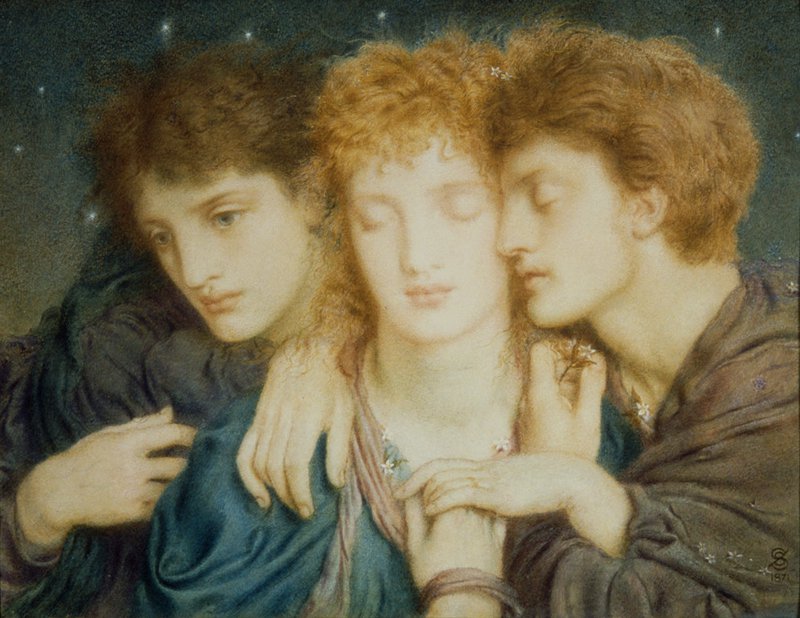DUPLEX II: JOHN RUSKIN AND SIMEON SOLOMON
Following the reading of Hiroshi Sugimoto’s work in terms of duplex telegraphy, our latest discussion considered the same technology in the context of John Ruskin’s lecture on ‘The Technics of Metal Engraving’ in Ariadne Florentina (1873). For Ruskin, engraving is purely linear: the engraver should not be overly (or at all) concerned with representing colour or light and shade, but line is key. This essential truth of engraving should be obvious from the first glance at a finished print. Ruskin felt that contemporary engravers had lost sight of this, becoming obsessed instead with the reproduction of painterly techniques. In duplex telegraphy terms, this is the equivalent of losing the balance between the outgoing message and the matching ‘dummy’ circuit: rather than cancelling each other out, the ‘noise’ from these signals muddies the incoming signal and the system becomes useless, a meaningless cacophony.
Several specific habits of contemporary
engravers cause Ruskin distress, all of which he puts down to the same
slavishly mimetic approach. One of these is painstaking perfectionism, which
leads the engraver to go over the same line repeatedly, gradually making it
deeper and smoother. The ‘old Florentine workmen constructed the line itself,
in important places, of successive minute touches, so that it became a chain of
delicate links…’; while the later (and in Ruskin’s terms, less elevated)
Renaissance engravers ‘cut their line … with a single furrow, giving it depth
by force of hand or wrist, and retouching, not in the furrow itself, but
with others beside it.’ The modern engravers, though, are tainted by ‘the
mechanical element introduced by their manner of execution’, and use
‘successive cuts’ in the same furrow.
This association with the mechanical suggests duplex’s ‘dummy circuit’, which automatically matches the outgoing message: it is consummately mechanical and intentionally empty, generated to silence noise rather than produce meaning; but it is also necessary, so that the incoming signal can be received clearly. This fits in with the next stage of Ruskin’s argument, in which he allows that there is some merit in reproductive engraving as a means for paintings to reach a mass audience. His quarrel is not with the existence of this kind of precise, reproductive engraving, its sole purpose the mimicry of another medium for distribution, but with the way it has flooded the market and corrupted the principles of engraving as an art form in its own right, so that its essential linearity has been forgotten. In this sense, the sophisticated accuracy of modern reproductive engraving is like the invention of duplex telegraphy, its apparently mechanical and meaningless detail (the ‘dummy circuit’) facilitating an enhanced flow of useful information.

Simeon Solomon’s watercolour The Sleepers and the One
that Watcheth (1870), apparently anti-linear in its tactile haziness,
nevertheless makes a compelling metaphor for duplex telegraphy. Three beautiful
heads are arranged close together, with five hands forming a strangely
geometric pattern around them, as though performing languid sign language. Telegraphically
speaking, the two sleepers, eyes closed, are mute: they embody the outgoing
signal and matching ‘dummy’ signal of duplex. The androgynous watcher, however,
is animated with a profound, if inward, gaze. Perhaps the others can sleep
because he watches for a message; but inversely, the receiver can understand
the message only if the outgoing signal is muted by the ‘dummy’ – in other
words, because those two currents ‘sleep’. This could additionally imply
secrecy or coded communication through which the uninitiated might ‘sleep’, as
well as the social suppression of potentially disruptive signals, particularly
in light of Solomon’s homosexuality (for which he was arrested twice before
being imprisoned in 1874, a scandal that destroyed his career). The picture is
simultaneously anxious and languid, its figures both entwined and divided,
literally conveying two signals at once. The central, frontal figure seems
almost to glow, while the encircling hands around the white neck suggest
insulation, and the heads pressed close on either side, all three haloed with
hair, imply a kind of radiance or electromagnetic field. Indeed, the whole
picture – velvety sky, delicate hair, smooth skin, limpid eyes and relaxed
fingers – is imbued with an electrical sensuousness, an effect that relies
heavily on Solomon’s distinctive watercolour technique.
The significance of medium, technique and truth to materials brings us back to Ruskin. At the end of his lecture, he reaches a pitch of impassioned indignation: having allowed the usefulness, if not the dignity, of reproductive engraving, he bemoans the debased appetite of the public for ‘Ramsgate Sands and the Paddington Station, because there you can see yourselves’. Just as printing technology broadly followed the principles of supply and demand, so did other communications technology: once duplex telegraphy was developed it served commercial interests more efficiently than before, becoming yet more susceptible to the increasingly powerful (and for Ruskin increasingly poisonous) pull of the market. These judgemental, almost hysterical views on the interaction between engraving technology and public morality echo anxieties about the rapid progress of other technologies, both in Ruskin’s time and the present: his comments on the empty-headed narcissism of the British public, for example, resonate with recent concerns over the proliferation of selfies and reality television. In the context of this argument, the sleeping couple in Solomon’s picture might be the oblivious mass of humanity, insulated from hardship and immersed in the pleasures of progress, while the watcher, like Ruskin, meditates upon its pitfalls. But the ethereal physicality of the picture expresses something that Ruskin’s argument fails to acknowledge: that human beings experience everything, including technology, through their senses and through the lens of their own identities. The visual representation of embodied consciousness that preoccupied many nineteenth-century artists, and which is so effective in this picture, offers a productive way to think about other concepts that are neither abstract nor tangible, such as electricity and its telegraphic technologies.
